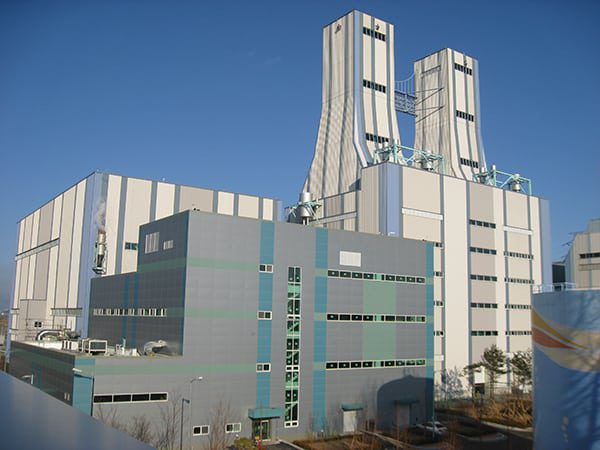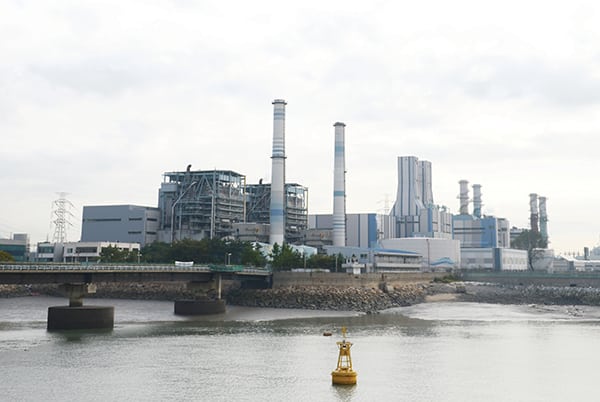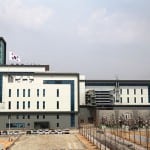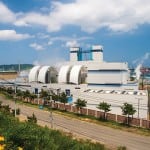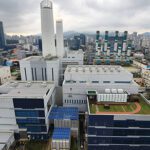Korea Midland Power (KOMIPO) had a viable combined cycle power plant where it didn’t need one, and growing demand where new capacity had to be added. The solution? Pack up and move. KOMIPO wins this year’s Marmaduke Award for excellence in power plant problem-solving. The award is named for Marmaduke Surfaceblow, the fictional marine engineer and plant troubleshooter.
Power plants are, with good reason, almost universally regarded as fixed assets to be operated, maintained, and retired on the spot where they were built. The idea of relocating something as large and complicated as a combined-cycle plant more than 100 miles away would strike many in the power sector as nonsensical. In most places, when the need for a plant declines, it gets bumped down the dispatch order and, if superfluous enough, mothballed.
But South Korea is not most places.
This East Asian nation of 50 million citizens has experienced years of booming electricity demand that has run ahead of its ability to maintain safe reserve margins. Last summer, grid operator Korea Power Exchange was forced to cut national power use by 6 GW to head off looming electricity shortages. The national energy ministry also demanded that local companies implement measures to reduce power use by 15% to avoid a grid failure. (For more on the nation’s power challenges, see “South Korea Walks an Energy Tightrope” in the November 2013 issue.)
That episode in 2013 was only the latest in a series of events that have challenged the nation’s grid stability. Similar circumstances led to rolling blackouts in September 2011, and the national reserve margin has at times dipped below 4%. (By way of comparison, the Electricity Reliability Council of Texas, which has struggled with reserve margins as much as any independent system operator in the U.S., recently implemented measures to keep its reserve margin above 13.75%.)
In such an environment, South Korea does not have the luxury of idling power plants that, through accidents of planning or geography, are being underutilized.
Power Mismatch
Korea Midland Power Co. (KOMIPO) is one of the five regional generation companies spun off from Korea Electric Power Corp. (KEPCO) in April 2001 as part of the restructuring of the national electric power industry. Headquartered in Seoul, it serves approximately 5.6 million customers in the country’s northwest. KOMIPO operates six plants with a total capacity of 8,934 MW, about 10% of the national total. It also currently has four plants with a capacity of 3,810 MW under construction.
KOMIPO’s largest plant is at Boryeong, with its flagship facility being the eight-unit, 4-GW Boryeong Thermal Power Plant, the largest coal-fired plant in South Korea and the nation’s first ultrasupercritical plant (and also a 2008 POWER Top Plant). There are several smaller gas-fired plants at Boryeong, as well as about 10 MW of hydro, solar photovoltaic (PV), and fuel cell generation.
Boryeong, however, is a significant distance from the capitol and its enormous power demand. Much of the capital’s power needs are served by KOMIPO’s Incheon Thermal Power Site, which has been supplying Seoul since the late 1960s (Figure 1). Originally a four-unit 1,150-MW oil-fired thermal plant, Incheon switched to liquefied natural gas (LNG) in 1987 in response to the national government’s fuel diversification policy.
By the 2000s, however, the original units at Incheon were nearing end-of-life. The 504-MW Incheon Combined Cycle Power Plant (CCPP) Unit 1 was added in 2005, and when the 509-MW CCPP Unit 2 was brought online in 2009, the decision was made to retire and dismantle thermal Units 3 and 4 while Units 1 and 2 received upgrades to extend their life a few more years. But to retire those units would mean adding new capacity to replace them.
Meanwhile, Boryeong CCPP Unit 4 was experiencing significant operational issues that were increasingly challenging its utilization. The high cost of LNG and the long distance to the capital demand center meant a low spot in the dispatch order despite the national power crunch. The plant was seeing capacity factors around 46%, and projections suggested this low utilization would continue to fall—perhaps under 10%—as the plant aged and fell behind newer, more efficient plants.
KOMIPO had proposed a new CCPP at Incheon as part of its input for the 4th Basic Plan for Supply & Demand of Electric Power (which took effect in 2008), and the national government had approved the plan. But increases in the price of LNG in 2009 caused the government to reexamine its plans for CCPP generation, and a new plant was likely to cost significantly more than initial projections. The need for new generation had not changed, but a more cost-effective approach needed to be found.
Faced with this dilemma, KOMIPO hit upon the idea of moving the underused plant at Boryeong to Incheon instead of building an entirely new plant. No one had ever attempted to move a power plant in South Korea before, but doing so would cost substantially less than a new one.
KOMIPO, KEPCO (which oversees the national grid), and the national government conducted feasibility studies of the idea during 2009, and the data suggested that the move would experience lower costs and fewer difficulties than a new greenfield plant, in part because of the opportunity to take advantage of existing infrastructure. An added plan to incorporate a new district heating system would also meet local demands for heating from expanding residential development in the Incheon area.
The proposal garnered strong support from the national and local governments. The project was incorporated into the 5th Basic Plan, and the national government expedited the necessary permitting and approvals in order to complete the project as quickly as possible. Incheon Metropolitan City also swiftly approved the project because of the need to increase local generation and district heating capacity.
Making It Happen
It was easy enough to propose moving a nearly 500-MW power plant, but making it happen was another thing entirely.
KOMIPO assembled a team to tackle the challenge. Hyundai Engineering provided the project engineering, while Kumho E&C and Keangnam Enterprises would handle the dismantling, transport, and construction. Alstom provided an upgraded compressor and a new combuster for the gas turbine, upgrades to the steam turbine and control system, and district heating integration. KEPCO KPS handled the disassembly and maintenance of the turbine as well as the additional upgrade work. KOMIPO handled its own procurement and maintained overall control of the project.
KOMIPO brought back many of the staff and contractors who had been involved in the construction of Boryeong CCPP Unit 4, including Alstom and Hyundai Engineering. This was necessary in part because many of the plans and blueprints from the original construction had been lost, and differences were discovered in the plant from those plans that were available because of later improvements and changes.
The project began in September 2009. The first hurdle was figuring out how to break down Unit 4 safely, without damaging the components, and without disrupting the operations of the rest of the plant.
Unit 4 was an Alstom KA24 power block consisting of two dual-fuel GT24 gas turbines, each with a triple-pressure Doosan Heavy Industries heat-recovery steam generator feeding a single Alstom STF30C three-casing, triple-pressure reheat steam turbine. All of these components would be reused in the new Incheon CCPP Unit 3.
But Unit 4 was also only one block of the four-unit Boryeong CCPP, and the rest of the plant had to continue operating during the project. This meant that the components of Unit 4 had to be carefully disconnected from the common-use facilities without disrupting normal operation. Every single part to be removed had to be identified, a meticulous plan had to be drafted to determine the order for each task, and this plan then had to be coordinated with Boryeong CCPP’s operating schedule so that the impact on operations would be minimized. For the most part, the work had to be conducted during periods of low demand on weekends and in the middle of the night.
This proved so challenging that the initial relocation and construction schedule was delayed considerably beyond the original dates. To minimize the delay, KOMIPO organized a Safe Facility Dismantling Task Force Team that developed a methodology to separate systems safely within the shortest possible time after comprehensive examination of related facility impacts.
The demands on the KOMIPO employees and contractors were considerable, but many of them voluntarily gave up weekends and took night shifts to keep the project moving. The staff took ownership of the job and carried out their work with a full sense of responsibility. As a result, though the initial schedule was delayed, in the end the dismantling work was completed without a single unplanned outage for the other three units.
Still, as anyone who has conducted a major repair or refurbishment project can attest, taking apart a plant that has been running for 15 years carries with it a lot of risks and unexpected events. Among other challenges, specialized lifting equipment had to be custom-designed to move several critical elements of the plant.
Though the project staff was fully committed, it had limited experience with this sort of work. Certain problems could not be avoided, and some damage to plant components occurred during the breakdown despite extensive protective measures—again, something to be expected when taking apart a plant with this much mileage on it.
Safety was also a key concern because the unusual nature of the job was sure to present many unforeseen risks. To meet this challenge, KOMIPO implemented rigorous accident prevention techniques across all job sites.
Community Outreach
Not everyone was initially in favor of the relocation project, however. During the time the Boryeong CCPP has been in operation, the formerly suburban site has been overtaken by urban sprawl, and the plant is now surrounded by large-scale residential development. And at the Incheon site, air quality was already poor because of numerous industrial activities in the area.
Public opinion on the proposed relocation was initially fiercely opposed, largely because of fears that a new power plant in Incheon would worsen already compromised air quality. To address these concerns, KOMIPO committed to implementing state-of-the-art emissions upgrades at the new plant and maintaining emissions well below national standards.
The company eventually resolved the public opposition by meeting with local officials, including regional citizen groups, local autonomous bodies, and regional representatives.
Moving Day
With the disassembly under way, KOMIPO had to address the next step: Getting the components the 180 kilometers from the old site to the new one.
The disassembled plant was packed into 7,500 separate modules for shipment. Modules that were small enough to move by road were loaded onto trucks and trailers. Of these, the smallest could be transported on the national expressways to the new site in about 4 hours. Larger shipments had to travel on local roads, a slower trip that took about 7 hours.
The largest elements, however, including the turbines and generators, had to go by sea on a 15,000-ton capacity barge. Though both plant sites are along South Korea’s west coast, local conditions made the trip very tricky. This region of the Yellow Sea can experience large tidal swings, in some areas as much as 25 feet, as well as strong currents. This meant the shipments had to be carefully coordinated with the tides, and contingency plans needed to be in place to shelter the barges in the event of unfavorable conditions. Though the trip would take about 12 hours in perfect conditions, in some cases it took several days to get the barges from Boryeong to Incheon because of the need to seek refuge from bad weather.
In all, it took three and a half months to move all 7,500 shipments to the new site (Figure 2).
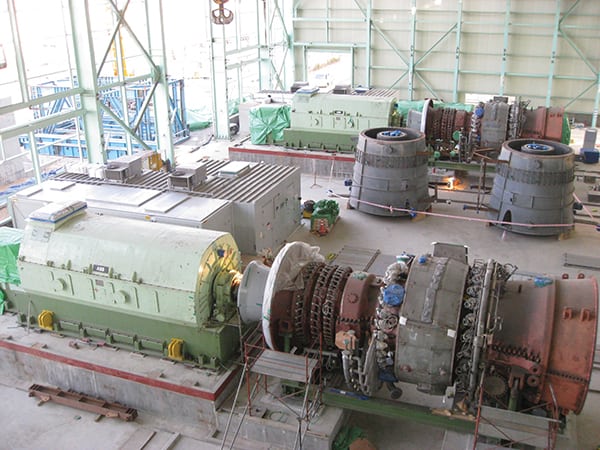 |
| 2. A new home. The two Alstom turbine generators are shown here, having arrived at the end of a long journey from the old plant. Courtesy: KOMIPO |
Back to Business
Reconstruction of the plant—now officially Incheon CCPP Unit 3—began on Sept. 13, 2010. The Basic Plan had the plant slotted for generation in the winter of 2012, meaning the team had a little over two years to complete construction, a challenge even with a brand-new plant.
The new plant would not be the same as the old one, however. Substantial improvements and upgrades were planned, beginning with incorporating district heating. The steam turbine was converted to a condensing extraction turbine, and a large heat exchanger was installed to connect to the local district heating system (Figure 3).
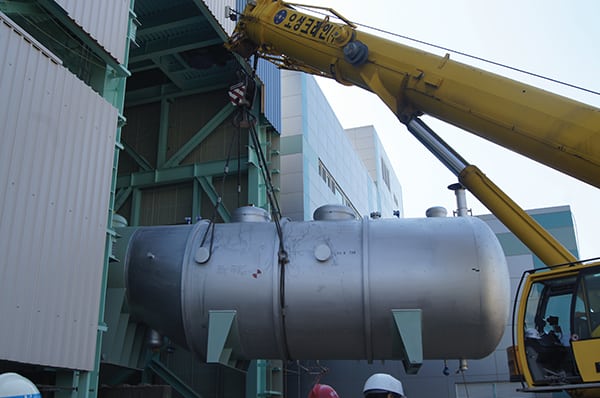 |
| 3. Hot prospect. As part of the plant upgrades, a new district heating system was installed. The plant is capable of putting out up to 382 MWt of district heat. Courtesy: KOMIPO |
The gas turbines received Alstom’s MXL2 upgrade package, including an improved Alstom compressor that improved efficiency by 3.5%, while output was increased from 292 MW to 321 MW. Though steam turbine power output dropped with the addition of district heating, the overall improvements and modifications boosted plant efficiency from 51.6% to 82.8%. As with the rest of the Incheon CCPP, Unit 3 operates on LNG.
Emissions were also improved by upgrading the turbine burners. The old components were replaced with Alstom’s EV Alpha Burner, which optimizes gas supply and reduces NOx to around 8 ppm. The new plant also added a selective catalytic reduction system, the first for a CCPP in South Korea.
KOMIPO took additional steps to reduce the impact on the local area. The plant exterior was carefully designed to present an attractive, aesthetically pleasing appearance through the use of graphic designs and landscaping. The new office and warehouse building included 304 kW of solar PV generation (Figure 4). Finally, though the plant relies on once-through ocean cooling, the water intake was designed to access deep seawater through an intake about 165 meters away from the plant, rather than using a surface-level intake. This would help protect local fisheries and avoid problems with cooling water intake that occurred at low tide.
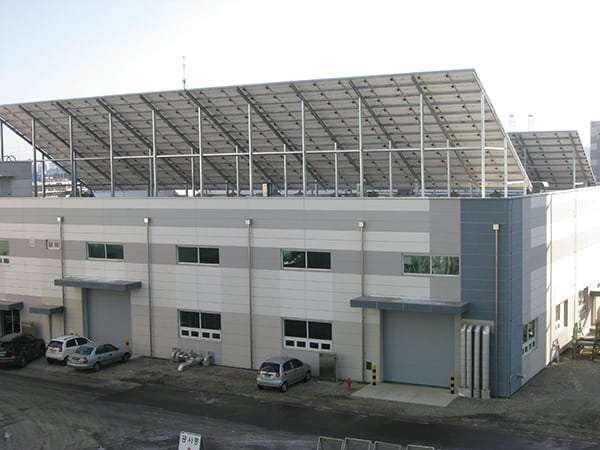 |
| 4. Shining bright. In addition to its attractive exterior, the new plant incorporates solar PV generation for its on-site buildings. Courtesy: KOMIPO |
A Job Well Done
Despite the numerous challenges, the relocation project was ultimately completed on time in December 2012, and the new plant was upgraded and commissioned without a single lost-time accident. In all, 4,600 people worked on the project from start to finish. The new plant entered commercial operation on Dec. 31, 2012, and was officially dedicated on July 3, 2013.
Operations at the new Incheon CCPP Unit 3 have vindicated KOMIPO’s decision to move the plant. The new unit has experienced much greater utilization, with a capacity factor of 77% since coming online. The project was completed for $272 million, 30% less than the cost of building a brand-new plant. Total output has been boosted to 532 MWe (in combined-cycle mode) with up to 382 MWt of district heating (power output in maximum heating mode is reduced to 446 MWe). The plant has met KOMIPO’s promise to keep emissions low, with NOx held to 6 ppm to 7 ppm on average.
For executing an extremely challenging plant relocation and upgrade, POWER recognizes KOMIPO and the project team with the 2014 Marmaduke Award. ■
— Thomas W. Overton, JD is a POWER associate editor (@thomas_overton, @POWERmagazine).


